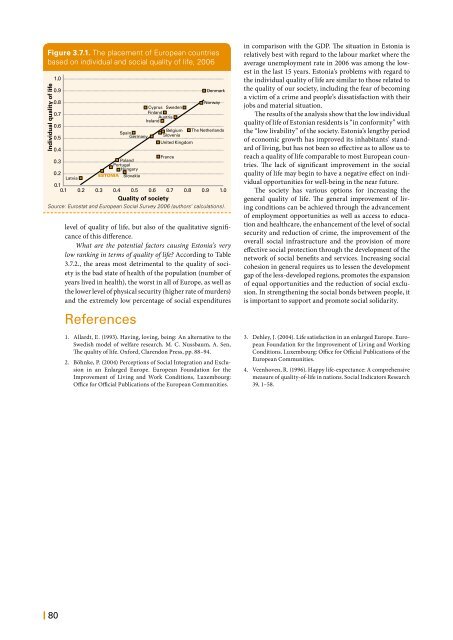Estonian Human Development Report
Estonian Human Development Report - Eesti Koostöö Kogu
Estonian Human Development Report - Eesti Koostöö Kogu
You also want an ePaper? Increase the reach of your titles
YUMPU automatically turns print PDFs into web optimized ePapers that Google loves.
Figure 3.7.1. The placement of European countries<br />
based on individual and social quality of life, 2006<br />
Individual quality of life<br />
1.0<br />
0.9<br />
0.8<br />
0.7<br />
0.6<br />
0.5<br />
0.4<br />
Spain<br />
Germany<br />
Cyprus Sweden<br />
Finland<br />
Austria<br />
Ireland<br />
Belgium<br />
Slovenia<br />
United Kingdom<br />
Denmark<br />
Norway<br />
The Netherlands<br />
France<br />
0.3<br />
Poland<br />
Portugal<br />
Hungary<br />
0.2<br />
Latvia<br />
0.1<br />
ESTONIA Slovakia<br />
0.1 0.2 0.3 0.4 0.5 0.6 0.7 0.8 0.9 1.0<br />
Quality of society<br />
Source: Eurostat and European Social Survey 2006 (authors’ calculations).<br />
level of quality of life, but also of the qualitative significance<br />
of this difference.<br />
What are the potential factors causing Estonia’s very<br />
low ranking in terms of quality of life? According to Table<br />
3.7.2., the areas most detrimental to the quality of society<br />
is the bad state of health of the population (number of<br />
years lived in health), the worst in all of Europe, as well as<br />
the lower level of physical security (higher rate of murders)<br />
and the extremely low percentage of social expenditures<br />
References<br />
1. Allardt, E. (1993). Having, loving, being: An alternative to the<br />
Swedish model of welfare research. M. C. Nussbaum, A. Sen,<br />
The quality of life. Oxford, Clarendon Press, pp. 88–94.<br />
2. Böhnke, P. (2004) Perceptions of Social Integration and Exclusion<br />
in an Enlarged Europe. European Foundation for the<br />
Improvement of Living and Work Conditions, Luxembourg:<br />
Office for Official Publications of the European Communities.<br />
in comparison with the GDP. The situation in Estonia is<br />
relatively best with regard to the labour market where the<br />
average unemployment rate in 2006 was among the lowest<br />
in the last 15 years. Estonia’s problems with regard to<br />
the individual quality of life are similar to those related to<br />
the quality of our society, including the fear of becoming<br />
a victim of a crime and people’s dissatisfaction with their<br />
jobs and material situation.<br />
The results of the analysis show that the low individual<br />
quality of life of <strong>Estonian</strong> residents is “in conformity” with<br />
the “low livability” of the society. Estonia’s lengthy period<br />
of economic growth has improved its inhabitants’ standard<br />
of living, but has not been so effective as to allow us to<br />
reach a quality of life comparable to most European countries.<br />
The lack of significant improvement in the social<br />
quality of life may begin to have a negative effect on individual<br />
opportunities for well-being in the near future.<br />
The society has various options for increasing the<br />
general quality of life. The general improvement of living<br />
conditions can be achieved through the advancement<br />
of employment opportunities as well as access to education<br />
and healthcare, the enhancement of the level of social<br />
security and reduction of crime, the improvement of the<br />
overall social infrastructure and the provision of more<br />
effective social protection through the development of the<br />
network of social benefits and services. Increasing social<br />
cohesion in general requires us to lessen the development<br />
gap of the less-developed regions, promotes the expansion<br />
of equal opportunities and the reduction of social exclusion.<br />
In strengthening the social bonds between people, it<br />
is important to support and promote social solidarity.<br />
3. Dehley, J. (2004). Life satisfaction in an enlarged Europe. European<br />
Foundation for the Improvement of Living and Working<br />
Conditions. Luxembourg: Office for Official Publications of the<br />
European Communities.<br />
4. Veenhoven, R. (1996). Happy life-expectance: A comprehensive<br />
measure of quality-of-life in nations. Social Indicators Research<br />
39, 1–58.<br />
| 80















